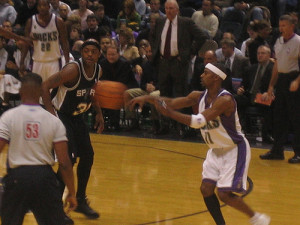Passing Starts with Your Feet
Passing is one of the cornerstone skills a player must master if they are to be able to play at any level of competition in basketball. Without effective passing amongst a team, many opportunities will never be explored or even realised within a team’s offensive possession. Poor passing is really about attention to detail at the fundamental level of the skill. One of the key aspects which lead to a successful performance of the passing technique is having players learn to generate power and control from using their feet within the process of performing a pass.
Passing forms one of the three fundamental skills that make up the triple threat stance. Early on players are taught this stance as a way of maximising their possession by looking to either shoot, pass or dribble (the order of which option is first depends on the age, ability, strengths and weaknesses of the individual player). To be able to utilise this stance at its optimum level a player must learn to use their feet in maintaining balance, control and generating power.
There are a number of different symptoms that can be attributed to a player not using their feet in forming a fundamentally correct passing technique. One of the more common problems seen in players not using their footwork correctly is their pass not happening quickly or with intensity in the full court. If a player fails to utilise their feet they will in turn not be able to generate as much power because they will only be using their upper body and none of the significant muscle groups of the lower body such as the legs and hips. A player suffering from this problem might not be able to efficiently down the sideline, or hit the basket lane runner on the fly from the backcourt.
This type of symptom though can just as easily be seen in the half court and highlighted when players are unable to generate pace when skipping a pass from one side of the floor to the other. If a player when passing across the keyway struggles to do so with pace then usually it can be attributed to the individual not steeping towards their intended target and using their feet to help generate force. As a result, a player suffering from this particular inefficiency will find that they often have their skip pass deflected or stolen by the defence when attempting the pass. To a lesser extent, a player might just find that when they skip the ball that the defence is always able to adjust with time and positioning so there is no advantage created.

So when analysing a player’s footwork what are the key points to emphasise?
- A player should use their lead foot to step towards the receiver
- Toes of the lead foot should point towards the target
- The player should remain in a low stance when generating the power needed to accelerate the ball and extend as this force is pushed through the ball; by doing this the best possible kinetic chain will be created for transferring of force
- The ball should be realised as the weight of the player is pushed off the back foot and onto the front foot; again specific to the kinetic chain
- A key point for all passing aspects to try and gain good vision of the target early
Effective passing makes a significant difference to the outcome of a game because a team will be able to utilise their possession to the greatest effect. Any competitive offense utilises passing to underline the basic principles of ball movement, spacing and creating different angles from which to drive.







